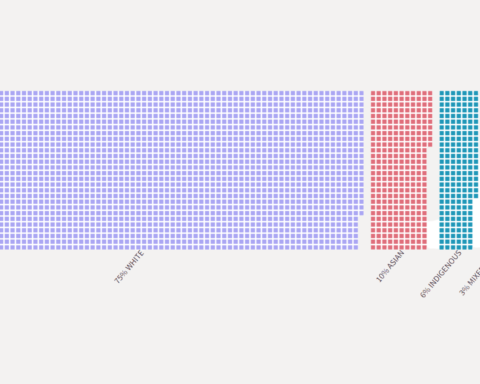Seven years ago, I was part of an application process to the Canadian Radio and Television Commission (CRTC) for a digital channel focusing on broadcasting English Language Drama with visible minority professionals in key creative positions, ownership and executive management – CanadaOneTV.
The application was denied.
The grounds for denial: the CRTC believed that the present broadcasting system would make the changes necessary to provide on-screen and off-screen representation of minorities.
“… To catch up to today’s population benchmarks for the whole of English Canada, for primary characters (on TV programs) would take about 10 to 15 years,” Kaan Yigit, President of Solutions Research Communications Group, told the CRTC at a license application hearing in 2007. “If you wanted to catch up to Toronto and Vancouver, it would take some 40 years plus.”
Yet, today, with the discussions of the future of broadcasting in Canada front and centre, still not enough is being said about the ongoing lack of diversity in Canadian programming. The Canadian Radio and Television Commission held highly publicized public hearings in Ottawa earlier this fall examining issues that will affect anyone with a television. A variety of proposals and changes to the current broadcasting landscape were discussed and dissected. That includes local broadcasting. With recent consolidation in the broadcasting industry and major cutbacks at the Canadian Broadcasting Corporation (CBC), local programming – including diverse characters and storylines representative of Canadian society – will definitely take a hit.
[…]Canadian broadcasters will face eroding domestic markets as immigrant populations increase and bypass Canadian broadcast media altogether. If Canadian screen media does not reflect their presence and their hopes and aspirations, except in stereotypical portrayals, why watch it?
Still, the issues concerning cultural diversity in broadcasting were not part of the hearings. They should have been, though. Some presenters did mention the topic, but an in-depth look at how representative our broadcasters are in their programming is long overdue. The CRTC says it will look at the issues surrounding cultural diversity on television at some point in the near future – though no date has been given.
Meaning of “should”
It seems little has changed since 2007. In fact, the Canadian Media Guild which represents producers, writers and creative workers reported to the CRTC at the recent hearings that over 10,000 jobs have been lost since 2007 due to economic and technological changes and industry consolidation. Many of these workers are recent hires — many of them from visible minority communities.
Mandated by the Canada Broadcasting Act (last revised in 1991), the CRTC is supposed to ensure that Canadian broadcasting media reflect the country’s ethno-cultural diversity as stated in sub paragraph 3(d) (iii):
“The Canadian broadcasting system should […] through its programming and the employment opportunities arising out of its operations, serve the needs and interests, and reflect the circumstances and aspirations, of Canadian men, women and children, including equal rights, the linguistic duality and multicultural nature of Canadian society and the special place of aboriginal peoples within that society.”
Unfortunately, the use of the word “should” in this clause has allowed for a large degree of interpretation and does not, it is argued, require specific commitments by the broadcasting system to ensuring cultural diversity is present in the system.
Part of the problem is the lack of an effective organization to advocate on behalf of producers and other creative artists from minority communities. Without an effective ongoing “voice” progress is slow in coming.
Over the years, the CRTC has implemented a variety of policy initiatives with respect to cultural diversity in broadcasting. A ruling by the CRTC, requiring broadcasters to measure current performance and set targets and goals for cultural diversity representation is an attempt to “encourage” improved performance in this area.
However, without specific requirements, and the resources required to adequately monitor and ensure compliance, particularly in the production of English Language Drama that reflects Canada’s cultural diversity, gains in this area appear to be insignificant.
The solution to these issues is not easy, given the complicated nature of the broadcasting industry and systemic issues involved, but the time is now for the CRTC to begin the work.
Diversify gatekeepers
The issue of representation of members from culturally diverse communities (visible minority groups in particular), in executive management positions, which are responsible for commissioning programs in television broadcasting organizations, has to be addressed if any real change is to take place. These positions, known as the “gatekeepers” in the industry – those who can “green light” a project – are almost exclusively from mainstream communities. This continues to affect both the quantitative and qualitative representation of cultural diversity on our television screens, particularly in the area of drama, sitcoms and variety programming.
Conducting empirical research requires adequate resources be allocated, which increasingly are in short supply at all government agencies, and without regulatory requirements, there is little incentive for private broadcasting companies to undertake this.
Part of the problem is the lack of an effective organization to advocate on behalf of producers and other creative artists from minority communities. Without an effective ongoing “voice” progress is slow in coming. Fortunately the media academics in a few universities across Canada, particularly those in large urban areas with larger ethnically diverse populations, are paying attention to this issue. A roundtable on Diversity in the Media Production Industry in January 2012 in Toronto, organized by Ryerson University professors, who have done extensive research on the representation of visible minority producers and writers in screen media industries, produced a report and action plan containing several important recommendations. These included calls on the CBC to set a more “vigorous example of diversity,” the creation of a new “diversity channel” and “tying current film and television tax incentives to diversity.”
Increase resources
Recently, OMNI television – a multilingual/multicultural TV station owned by Rogers Media – argued that economic conditions including the reduction of advertising revenues and the increased competition from new digital platforms available via the Internet were forcing a reduction in multilingual/multicultural programming it could offer. The CRTC didn’t accept the argument, saying the company had not provided sufficient evidence or information to support its case and that it would review the matter at the company’s next licence renewal hearing.
OMNI’s business model, like other Canadian networks, and as approved by the CRTC, is to broadcast primarily U.S. programs (mostly sitcoms and talk shows) in primetime and produce some “in house” news and studio-based talk shows aimed at ethnic communities, for which production costs are paid for by advertising sales and sponsorship from local business.
The CRTC set the amount of money that needed to be spent by the channels on these “CanCon” programs, and the number of hours and types of programs that should be produced as, “conditions of licence.” Due to market realities these programs are rarely profitable.
The CRTC says it will look at the issues surrounding cultural diversity on television at some point in the near future – though no date has been given.
As part of its commitments in order to obtain licences for a second multicultural channel, OMNI 2 also committed to spending $46.5 million on producing original Canadian documentary and drama programs over the period of its initial licence. That has been a success, though temporary.
The fund created valuable opportunities for producers and creative screen artists to develop their skills in the industry and tell stories from their own ethnic communities. In many ways, it served as a valuable “incubator” for many creative artists in the screen industries. However, it’s a one-time initiative. Where will these niche producers find more work? The need for sustainable, consistent funding is evident.
Implement clear policy regulations
The need for regulations in the screen media industries is well established. It is now time to take the issue of screen representation in front of and behind the camera of culturally diverse and visible minority communities seriously and take concrete measures to deal with their under- representation in an increasingly important and influential medium.
The implications of not doing so will be serious for Canadian society – an increasing disassociation from mainstream Canadian society by visible minority communities, especially “at-risk” youth, with a resulting loss of social cohesion in our communities. Recent studies by University of Toronto professors Jeffrey Reitz and Rupa Banerjee have outlined this clearly. As well, Canadian broadcasters will face eroding domestic markets as immigrant populations increase and bypass Canadian broadcast media altogether. If Canadian screen media does not reflect their presence, and their hopes and aspirations, except in stereotypical portrayals, why watch it? With programming now easily available from individuals’ home countries via the Internet and Canadian-based “third language” TV channels, there is little incentive to watch Canadian programming.
If the CRTC doesn’t take action immediately, it is bound to have negative effects on our social fabric and our sense of identity as Canadians. Can we as a society that prides itself on our diversity, multiculturalism and commitment to equality and equity afford to take these risks? I’m not sure we can.
Paul de Silva, is a film and TV producer and a doctoral student in the Communications and Culture Program at Ryerson University and Co-director of the International Diaspora Film Festival.




